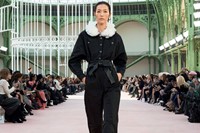It has gone over precisely no one’s head within the bubble of fashion – and, actually, now quite far outside its reaches – that the house of Chanel is currently without a creative lead. Names have been enthusiastically flung into the ring for the past few months, with increasingly feverish speculation. Why? Because Chanel is not only one of the world’s biggest luxury houses, but sports one of its most magnetic histories. Gabrielle Chanel was the only fashion designer named in Time magazine’s list of the hundred most influential people of the 20th century – because Chanel transcended the limitations of the industry, inventing a style not once, but twice. She altered the way people dressed. What a legacy.
Thus, when Chanel should have been rudderless without a creative lead, in actual fact it could sail along just fine for its Spring/Summer 2025 ready-to-wear collection. The design team responsible for the collection had done their homework – thanks to multiple Chanel exhibitions (Gabrielle Chanel. Fashion Manifesto is currently on view in Shanghai), and the few hundred books published about her and her clothes over the years. And also thanks to Chanel’s own extensive archives, kept hermetically sealed on the outskirts of Paris.
It was there, for instance, that the design team discovered a surreal dress from Spring/Summer 1939, trimmed in feathers and printed with artistic illustrations of the fronds. They revived that for 2025. They also, possibly, wound up watching a few videos on YouTube, like Jean-Paul Goude’s 1991 Coco perfume campaign, with Vanessa Paradis perched in a giant gilded cage (symbolism much?). In white, a reiterated version of that cage punctuated the nave of the Grand Palais – which we entered through the ‘Gabrielle Chanel’ entrance, rechristened after Chanel’s bank-busting support of the restoration of the monumental building. Chanel’s cultural capital is difficult to beat.


The collection itself riffed gently on those ideas – birds, feathers, twisted into ceaseless Chanel-isms. Riley Keough, Elvis’ granddaughter, played Paradis and swung on a perch in the cage while singing When Doves Cry – more bird symbolism. Incidentally, Chanel’s nickname of ‘Coco’ came from a cabaret song where she impersonated a cockerel’s crow – a ‘cocorico’, in French. And the collection itself was a breezy, easy whirlwind trip through Chanel’s timeless and ever-relevant house codes, from lightweight tweeds and jerseys, to billowy chiffons, to graphic black and white, in 77 riffs. Bows were knotted at the neck, pearls dangled, shoes were two-tone – although in their jacked-up platform proportions, they reminded you of Karl Lagerfeld’s ‘Minnie Mouse’ Chanel shoes of the early 1990s.
Lagerfeld’s ghost was as present here as Gabrielle Chanel’s, the endless remixer of her original greatest hits. So alongside classic tweeds, they came in Candy Crush colours, crashed together with denims – as Lagerfeld first did, scandalously, in 1991 – and cropped to mini level. Even that throwback to 1939 was a Lagerfeldian nod – he sometimes claimed to have been born in 1939 (making him a teen prodigy when he won the 1954 Wool Secretariat Prize alongside Yves Saint Laurent, as opposed to an astute and trained 21-year-old designer). And he often said that Chanel’s clothes of the 1930s were his favourite – they reflected his youth, the wardrobe his mother wore. So to see its reincarnation roaming the aisles of the Grand Palais, where he staged Chanel’s biggest triumphs, was satisfying.
Yet both that – and those Minnie Mouse platforms – reminded everyone present how big Lagerfeld’s shoes are chez Chanel, a creative director who managed to recreate a fashion house not in his own image, but in an image he devised and edited from an original – sharpened, retouched and redeveloped, like the expert photographer Lagerfeld was, alongside designer, author, wit, even dietician. It’s difficult to imagine who could follow – to borrow one of his aphorisms, scrawled under an image of the Chanel suit he ceaselessly reinvented: “Not what, but how next?” That’s exactly the question around Chanel, although this superb show of exactly what Chanel stands for then and now, was far greater than a mere exercise in treading water.






